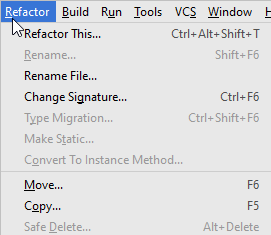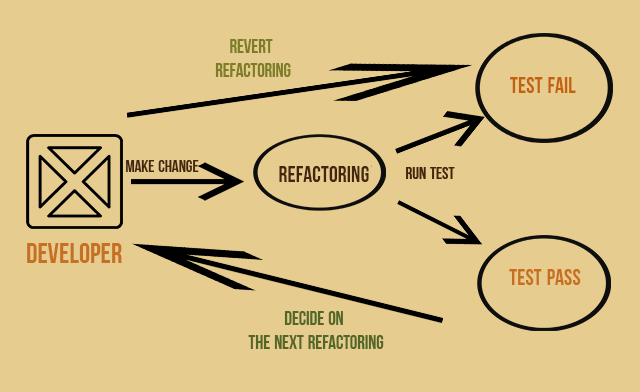In this article, we will thoroughly analyze such a concept as code refactoring, and show its influence on different members of a project team, especially on a QA department.

Code refactoring
The concept of refactoring is used to correctly identify a need to clear or rebuild a program code.
Introduction to Refactoring
So, refactoring is basically a special practice or a process of improving the program code or database while keeping the initial functionality. The main point is to change non-effective and low-quality code into a practical and easy-to-use tool for further programming, as well as to make it simple for multiple usages by developers.
In recent years, code refactoring gains momentum and becomes a usual practice in the everyday work of many companies. Especially it concerns those firms that use Agile Software Development.
What Is the Need for Code Refactoring?
If we save the initial functionality of the application or module, the question is, why do we need refactoring? There are many reasons, why some modules or parts of code may need reconfiguration, for example:
- Code smells;
- Missing the schedule of software distribution before its release;
- A need to use a flexible approach to software development.
Let’s take a look at each of these parts separately.
Code Smells
A simple example, when products start smelling bad, it means that they are spoilage, and people get rid of them. Program code can also “smell” and be “expired”.
Thus, the technical validity of the program code depends on the following factors:
- Repetitive or identical code;
- A declared variable that isn’t used in the rest of the code;
- Difficult design of the code;
- A big amount of cycles and conditions that can be easily improved or technically simplified.
After some time, these problems become even more obvious. As an application or system continues to grow, the “smell” of its code starts influencing the development, support, and even system performance in extreme scenarios.
Missing the Schedule of Software Distribution Before Its Release
All the time, when it’s a deadline for delivering the technical functionality, companies try to release a product with a maximum number of functions.
But there can happen a situation with so-called technical debt when there is a need to improve or deploy some changes with correct actions (in the client’s opinion).
The relatively old product can have a huge technical debt after a while. Whereas, it can make the product more vulnerable to failures and hinder its technical support and further maintenance.
A Need to Use a Flexible Approach to Software Development
A flexible approach to software development implies the improvement of the technical skills of the whole team. If the teams don’t use an easily maintainable code, they cannot develop the current code while upgrading any integration.
If one doesn’t change code without a sample refactoring, these processes can lead to technical debt or code smell.
Why Should QA Be Familiar With Code Refactoring?
The answer to this question can be divided into different categories. Each of them will characterize some group of testers according to their engagement rate in the project.
#1 For Unit Testers/Developers
In the case of code refactoring, old CSS classes are upgrading while the new program code is added. To be more specific, the new unit tests appear, and the old ones aren’t executed.
Also, it is worth noting that module tests cannot be performed for all the outdated systems. Then one should create new sets of unit tests that require specific configurations.
#2 For Testers
In the case of code refactoring, specialists should understand that initial task and software logic stays the same.
For an ordinary tester, code refactoring is the following formula: in-depth testing + regression testing. In-depth testing is a functional check in the context of potential software usage by all the possible user groups. For example, if it is an online shop, we should test the web site behavior on the part of a shop assistant and a customer.
We need regression testing to make sure that the upgrading of the functional module hasn’t changed or broke anything. Except for these tests, one should pay his/her attention to load tests and security tests.
#3 For Automation Test Engineers
Sometimes, the code refactoring can cause full or partial failures of automated scenarios (scripts).
As a rule, it is due to the following reasons:
- Objects changed their positions, and their indicators were established in Selenium tests. Next time messages with errors will be sent to the logs.
- If the code has some technical changes that weren’t transferred into the build after refactoring.
Considering this, it is recommended to automate tests after the technical part of the functional module is stable in the completely verified form.
All automation testers should think like developers and always try to create a clean and clear code. By the way, a lot of code integration tools, such as IntelliJ IDEA or Eclipse, have built-in functionality for refactoring with simple configuration parameters.

Example of refactoring in IntelliJ IDEA
#4 For Test Leads / QA Leads
In different software testing companies, a lot of test leads or QA leads often face a need for technical communication with developers, analytics, and even clients for which exhaustive testing of the functionality is the most important moment in software development.
Also, they have to understand the peculiarities of program functionality from the technical side. On the basis of successful refactoring, members of test leads / QA leads groups should create analytical business plans intended for clients and users.
And if you test a web product that completed the refactoring process, and you need new testing tools or testing methods, you should establish communication with developers in order to avoid dead time.
Example of Code Refactoring Testing
Further, we will model a possible example from the real life of any product company when tester can and/or must work with program code after its refactoring.
So, the possible task can be the following: to execute a module refactoring for editing the encoded variables with the further commenting of the new tools for automated generation of the technical documentation.
The potential challenge is in the fact that there are no serious tasks for testers. Because the module is new and it has approved functional specification, a set of unit tests was performed with the initial refactoring launch.
There were retrial tests of the module and a known failed part of the code. The developer was notified about all the bugs right away, and he/she fixed them before product release.
As you can see, it is not that complicated, if you manage the testing process correctly and in time.

Approximate scheme of code refactoring
Conclusion
To sum up, we have to say that refactoring is quite important stage of clearing and improving the code during the whole software lifecycle. This process can be both, simple (new comments adding, keeping the correct indentation units) and difficult (changing the old system to new software logic).
Relating to testers, code refactoring is based on the processes of in-depth testing + regression testing (regardless of the stage of check involvement and its role on the project).
It is testers who are responsible for the correct functioning of any software.










Leave A Comment